Before buying any cookware, do you check the labels or pay attention to what’s written on it? Is it environmentally friendly, free from toxic chemicals, and made of good quality materials? If yes, then it is good but if not, then you should do it next time.
Both hard-anodized and ceramic cookware have lots of similarities. That’s why people get confused to choose the right one. But, they have some key differences that make them different from one another, and after reading this article on hard-anodized vs ceramic cookware, you can easily choose the desired one.
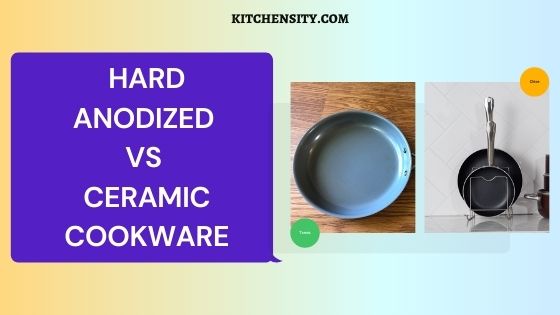
All the pros, cons, and features of both cookware will be covered so that all confusion gets cleared.
Without any delay let’s start.
Table of Contents
- 1 Hard-Anodized Vs Ceramic Cookware
- 2 What Are Ceramic Cookware?
- 3 Pros And Cons of Ceramic Cookware
- 4 What Are Hard-Anodized Cookware?
- 5 Pros And Cons of Hard Anodized Cookware
- 6 Hard-Anodized Vs Ceramic Cookware Comparison
- 7 Which Is Healthier Ceramic Or Hard Anodized Cookware?
- 8 What Is Better Hard Anodized Cookware Or Ceramic?
- 9 Is Hard Anodized Aluminum Safe?
- 10 You May Also Like
- 11 Final Thoughts: Hard-Anodized Vs Ceramic Cookware
- 12 FAQ’s
Hard-Anodized Vs Ceramic Cookware
Both hard-anodized and ceramic cookware have their own set of advantages and disadvantages. Hard-anodized cookware is more durable and can withstand high heat and repeated use, while ceramic cookware is non-toxic and ideal for low to medium-heat cooking. When it comes to cost, hard-anodized cookware is generally less expensive than ceramic cookware.
Ultimately, the choice between the two depends on personal preferences, cooking habits, and budget.
What Are Ceramic Cookware?
Ceramic cookware is made of metal pans where a coating of sand or silicone is used to make it smooth and glossy. They are made from naturally occurring materials. That’s why they are considered as environmentally friendly cookware.
Its smooth surface prevents the food from sticking and hence makes cooking and cleaning easy. It is free from any harmful chemicals and also non-reactive. You can cook almost anything you want. The ceramic pans can withstand higher heat than any traditional non-stick pans. It also holds the temperature for a long time and can cook food even after the flame is off.
Ceramic pans don’t chip that easily. But that’s not to say that they’re completely immune to chipping. And once it happens, the cookware becomes completely useless, as it’s no longer able to conduct heat evenly. It’s for this reason that you’re advised to place some padding in between each ceramic pan or pot while storing them. This should help in preventing them from chipping, thus extending their usability.
But compared to hard-anodized cookware, ceramic cookware is a bit costly. Due to its quality and healthy features, its price got a little higher. So, let’s check out the features, pros, and cons of ceramic cookware.
Features
- These pans are free from harmful toxic chemicals like PTFE, PFOA, lead, and cadmium.
- It is safe from toxic fumes even if you accidentally overheat the pan.
- They are made from naturally available materials to make them environment-friendly.
- Some of the popular brands provide a diamond-infused ceramic coating.
- They are durable, scratch-resistant, and metal utensil-safe. However, this feature is limited to certain brands.
- Ceramic pans don’t chip that easily but they are not completely immune to chipping.
- They are dishwasher-safe and oven-safe up to 600 degrees Fahrenheit.
- Most of the pans are suitable for all cooktops including induction if the base is made of high-grade aluminum.
Pros And Cons of Ceramic Cookware
PROS
- It is easy to clean and cook.
- They look very attractive due to their various color options.
- You can store your food in them without worrying about anything.
- They don’t chip easily.
- Safe from harmful chemicals and toxic fumes.
- Environment-friendly cookware.
CONS
- Not durable compared to hard-anodized.
- They’re not 100 percent effective in preventing food from sticking.
- They are also not made to cook for high heat as hard-anodized.
Some Of The Best Ceramic Cookware
After researching a lot, I have found some of the best ceramic cookware of trusted brands.
- GreenPan Chatham Ceramic Non-Stick Cookware Set
- GreenPan Valencia Pro Ceramic Cookware Set
- MICHELANGELO Copper Pots and Pans with Ceramic Titanium Coating
- WearEver Ceramic Nonstick Cookware Set
What Are Hard-Anodized Cookware?
In simple words, anodization is a scientific technique used to coat a layer of protection over metals to prevent them from any reaction and also, to make them strong and durable. So, in hard-anodization cookware, a layer of protection is coated over the aluminum to make it strong and non-reactive.
The cookware becomes stronger than most other cookware and the anodization fills up the gaps and makes it nonsticky. The surface becomes very smooth and easy to cook and clean. You can cook anything in these pots and pans because they are non-reactive and nonstick. The cookware will last you for decades if you use it properly and season it from time to time.
Now, let’s check its features.
Features
- These cookwares are stronger than stainless steel, long-lasting, and nonstick.
- Its construction helps it to heat up quickly. The heat is distributed evenly and prevents hotspots.
- This type of cookware is metal utensil-safe, dishwasher-safe, oven-safe, and scratch-free.
- They are safe from toxic chemicals and PFOA, PTFE, Lead, and Cadmium free.
- Most brand’s hard-anodized cookware is compatible with almost all cooktops including induction.
- These pots and pans are designed for professional performance and are dense, non-porous, and highly wear-resistant.
- Most brands provide ergonomically designed handles secured with double rivets for extra protection.
Pros And Cons of Hard Anodized Cookware
You have checked the definition and features. Now, it’s time for the pros and cons.
PROS
- Easy to cook and clean.
- They are non-reactive and are free from toxic chemicals.
- Strong, durable, and scratch-resistant.
- High cooking performance.
- Its even distribution of heat prevents hotspots.
- Comes with a limited lifetime warranty.
CONS
- Avoid high heat. Good for medium to medium high-temperature cooking.
- Cooking spray can’t be used.
- Expensive than regular nonstick cookware but worth it.
Some Of The Best Hard-Anodized Cookware
After researching a lot, I have found some of the best hard-anodized cookware of trusted brands.
- All-Clad E785S264/E785S263 HA1 Hard Anodized Nonstick
- Cuisinart Chef’s Classic Nonstick Hard-Anodized
- T-fal Ultimate Hard Anodized Nonstick
- Rachael Ray Cucina Hard-Anodized Nonstick Cookware
Hard-Anodized Vs Ceramic Cookware Comparison
You have seen all the features, pros, and cons of both cookware. Now it’s time to compare them and see who wins the comparison.
Comparison Table
| PARTICULARS | HARD-ANODIZED | CERAMIC |
|---|---|---|
| Style and Varieties | No | Yes |
| Durability | Yes | No |
| Scratch Resistant | Yes | No (But some brands do provide it) |
| Even Heat Distribution | Yes | Yes |
| Environment Friendly | No | Yes |
| Health Aspect | Yes (According to FDA, hard-anodized cookware is not harmful to health) | Yes |
| High Heat Retention | Yes | Yes (But some brands do provide it) |
Health Benefits
Traditional non-stick cookware often contains a group of chemicals called perfluoroalkyl substances (PFAS), including perfluorooctanoic acid (PFOA), which can be harmful to human health. These chemicals can leach into food when heated, especially at high temperatures, which can potentially cause health problems like cancer, liver damage, and reproductive problems. PFOA has been linked to several health issues, including developmental problems in children and an increased risk of certain types of cancer.
Ceramic Cookware
- It is free from these harmful chemicals, making it a safer alternative for cooking.
- Ceramic coatings are made from natural minerals and are considered to be non-reactive.
- It means that they do not release any harmful substances into the food while cooking.
Another type of cookware that is free from these chemicals is hard-anodized cookware.
Hard-Anodized Cookware
- It is made by subjecting aluminum to an electrochemical process that creates a hard, non-reactive surface that is resistant to scratching and corrosion.
- This type of cookware is also considered safe for cooking and is a popular alternative to traditional non-stick cookware.
In summary, by using ceramic or hard-anodized cookware instead of traditional non-stick cookware, you can reduce your exposure to harmful chemicals and potentially improve your overall health.
Durability
When it comes to durability, hard-anodized cookware has a few distinct advantages over ceramic cookware.
- First, hard-anodized cookware is much less likely to scratch or chip than ceramic cookware.
- This is because hard-anodized cookware is made by treating aluminum with an electrochemical process that creates a hard, non-porous surface.
- This surface is highly resistant to abrasion, which means that it can withstand years of use without showing significant signs of wear and tear.
- Another advantage of hard-anodized cookware is that it can withstand high heat without warping or becoming damaged.
- This is because the hard-anodized surface can distribute heat evenly, which means that there are no hot spots that can cause warping or other damage.
- This makes hard-anodized cookware ideal for high-heat cooking methods like searing, frying, and sautéing.
Overall, hard-anodized cookware is an excellent choice for anyone who wants durable, long-lasting cookware that can withstand frequent use and high heat.
While ceramic cookware can also be durable, it is more susceptible to scratching and chipping, and it may not be able to withstand the same level of heat and use as hard-anodized cookware.
Cooking Performance
When it comes to cooking performance, both ceramic and hard-anodized cookware have their strengths.
Ceramic Cookware
- It is known for its ability to distribute heat evenly, making it a great choice for dishes that require slow and steady cooking.
- It is also great for dishes that require low to medium heat, such as soups, stews, sauces, and slow-cooked meats.
- The smooth, non-stick surface of ceramic cookware makes it easy to cook delicate foods like fish, eggs, and pancakes without the need for a lot of oil.
- However, it’s important to note that ceramic cookware is not the best choice for high-heat cooking or searing, as it can be more prone to cracking or chipping when exposed to sudden changes in temperature.
Hard-Anodized Cookware
- On the other hand, hard-anodized cookware is a great choice for high-heat cooking and searing.
- It can handle temperatures up to 500 degrees Fahrenheit without warping or scratching, making it ideal for dishes that require a quick sear or for browning meat.
- The durable surface of hard-anodized cookware also makes it resistant to scratches and chips, ensuring that it can withstand repeated use over time.
- However, because it is a good conductor of heat, hard-anodized cookware can heat up quickly, making it easy to burn food if you’re not careful.
So, if you’re looking to cook delicate foods like fish, eggs, or pancakes, ceramic cookware is a great choice. If you want to sear a steak or cook a stir-fry, hard-anodized cookware is the way to go. Of course, both types of cookware can be used for a wide range of dishes, so it’s ultimately up to personal preference and the specific needs of the recipe.
Cost Of Cookware
Ceramic cookware is generally more expensive than hard-anodized cookware, and there are a few reasons for this.
- One reason is the materials used to make ceramic cookware.
- Ceramic cookware is typically made from a combination of clay and other natural minerals, which are mixed and then fired at high temperatures to create a hard, durable surface.
- These materials can be more expensive than the aluminum or stainless steel used to make hard-anodized cookware.
- Another reason is the manufacturing process. Making ceramic cookware involves a more complex process than making hard-anodized cookware.
- The clay mixture must be carefully formed and fired in a kiln, and then coated with a non-stick surface.
- This process can be more time-consuming and labor-intensive than the process used to make hard-anodized cookware, which involves treating the surface of the cookware with an electric current to create a hard, non-stick surface.
However, the extra cost of ceramic cookware may be worth it for people who are looking for high-quality, long-lasting cookware. Ceramic cookware is known for its excellent heat retention and distribution, and it can provide even cooking and prevent hot spots.
Additionally, ceramic cookware is free from toxic chemicals and is an excellent option for people who want to avoid chemicals in their cookware.
On the other hand, hard-anodized cookware is a more affordable option that still provides many of the same benefits as ceramic cookware. It is durable, scratch-resistant, and can withstand high heat and repeated use over time.
While it may not have the same level of heat retention and distribution as ceramic cookware, it is still a good choice for many types of cooking. Ultimately, the choice between ceramic and hard-anodized cookware will depend on individual preferences and needs.
Maintenance
Maintaining your cookware is an important aspect to consider when deciding on which type of cookware to buy. Here is some more information on how to care for each type of cookware:
Ceramic Cookware:
- To prevent chipping or cracking, it’s important to use padding or protective covers when stacking or storing ceramic cookware.
- Avoid using metal utensils, as they can scratch the surface of the ceramic. Instead, use wooden, silicone, or nylon utensils.
- To clean ceramic cookware, use a soft sponge or cloth with mild dish soap and warm water. Avoid using abrasive cleaners, as they can scratch the surface.
- If you notice any staining on the surface of the ceramic, try using a paste made of baking soda and water. Apply the paste to the stain and let it sit for a few hours before washing it off.
Hard-Anodized Cookware:
- Before first use, season your hard-anodized cookware by rubbing a small amount of cooking oil onto the surface and heating it on medium-high heat for a few minutes. This will help create a non-stick surface.
- To clean hard-anodized cookware, use warm soapy water and a non-abrasive sponge or cloth.
- Avoid using harsh cleaners, such as bleach or oven cleaners, as they can damage the surface.
- If you notice any discoloration on the surface of your hard-anodized cookware, try using a mixture of baking soda and water to gently scrub the area.
- Hard-anodized cookware is dishwasher safe, but hand washing is recommended to extend its lifespan.
Overall, both types of cookware require a certain level of care and maintenance to ensure they last for many years.
However, ceramic cookware is generally more fragile and requires more care to prevent chipping or staining. Hard-anodized cookware, on the other hand, is more durable and can withstand more wear and tear.
Which Is Healthier Ceramic Or Hard Anodized Cookware?
Both ceramic and hard-anodized cookware can be healthy options for cooking, as long as they are used properly and are not damaged or worn.
Ceramic Cookware
- Made from natural materials such as clay and sand.
- Does not contain toxic chemicals such as PFOA and PFAS found in some traditional non-stick coatings.
- A safer option for those concerned about the potential health risks of these chemicals
- Can be prone to chipping, and if the ceramic coating is damaged, it can potentially leach harmful heavy metals into food.
Hard-Anodized Cookware
- Made from aluminum that has been electrochemically treated to create a hard, non-stick surface.
- Resistant to scratching and wear.
- Free from PFOA and PFAS.
- Some people have raised concerns about the potential health risks of cooking with aluminum, although studies have shown that the amount of aluminum that leaches into food from hard-anodized cookware is negligible.
Ultimately, both ceramic and hard-anodized cookware can be healthy options if they are used properly and are in good condition.
It is important to follow the manufacturer’s instructions for each type of cookware, including using appropriate utensils and avoiding high heat settings that can damage the non-stick coating.
What Is Better Hard Anodized Cookware Or Ceramic?
Whether hard-anodized cookware or ceramic cookware is better depends on your specific needs and preferences. Here are some key factors to consider:
- Health: Both types of cookware are generally considered safe, as long as they are used properly.
- Ceramic cookware is free from harmful chemicals like PFOA and PFAS, which are sometimes found in traditional non-stick cookware.
- Hard-anodized cookware is also free from these chemicals, but it is important to note that some hard-anodized cookware may have a non-stick coating that could potentially contain PFOA or PFAS.
- Durability:
- Hard-anodized cookware is generally considered to be more durable than ceramic cookware, as it is less likely to scratch or chip. It can also withstand high heat and repeated use over time.
- However, if you take proper care of your ceramic cookware by using padding and avoiding sudden temperature changes, it can also last for many years.
- Cooking Performance:
- Ceramic cookware is best for low to medium-heat cooking, as it tends to heat up slowly and evenly. It is great for soups, stews, and sauces.
- Hard-anodized cookware, on the other hand, is better for high-heat cooking and searing. It is great for stir-fries, grilled meats, and other dishes that require high temperatures.
- Cost: Ceramic cookware is generally more expensive than hard-anodized cookware, as the materials used to make it are more expensive and the manufacturing process is more complex. Hard-anodized cookware is a more affordable option for those on a budget.
- Maintenance: Both types of cookware require different types of care.
- Ceramic cookware is more prone to chipping and requires padding to prevent damage.
- Hard-anodized cookware should not be cleaned with abrasive materials, as this can damage the non-stick coating.
- It is important to follow the manufacturer’s care instructions for both types of cookware to ensure that they last as long as possible.
In conclusion, neither hard-anodized cookware nor ceramic cookware is objectively better than the other. Your choice should depend on your specific needs and preferences, as well as your budget.
Is Hard Anodized Aluminum Safe?
Yes, hard anodized aluminum cookware is generally considered safe to use. The hard anodization process creates a layer of oxide on the surface of the aluminum, making it non-reactive with food and less likely to leach into your food.
This means that there is minimal risk of aluminum toxicity or other health concerns associated with using hard anodized aluminum cookware. However, it’s important to note that the safety of any cookware can depend on factors such as the quality of the manufacturing and the care taken in its use and maintenance.
Additionally, it’s always a good idea to follow the manufacturer’s instructions and to avoid overheating the cookware, which can cause damage or create fumes.
You May Also Like
- How To Fix Scratched Non-Stick Pans?
- How To Remove The Non-Stick Coating From Cookware?
- Why Do Metal Handles Of Pans Get Hot?
- Does Enamel Cast Iron Chip?
- How to Season a Nonstick Pan for the First Time?
- Hard-Anodized Vs Stainless Steel Cookware
- Stainless Steel vs Nonstick vs Ceramic Cookware Set (An Ultimate Guide)
Final Thoughts: Hard-Anodized Vs Ceramic Cookware
As you have seen both of the cookware have lots of similarities but one is strong and durable and the other one is stylish and environment-friendly. If you want cookware that is stylish and environmentally friendly, then go for ceramic but if you want durable and high heat retention cookware then go for hard-anodized.
If you ask me then I would opt for hard-anodized as it is also free from harmful chemicals, durable, and almost compatible with all cooktops. Last, we want a value-for-money product so it is worth it. So, if this article helped you to choose the right cookware for your kitchen then, please share it with your friends and family.
Now, it’s your turn to choose the desired one. So, which one will you choose? Don’t forget to leave your valuable comment below.
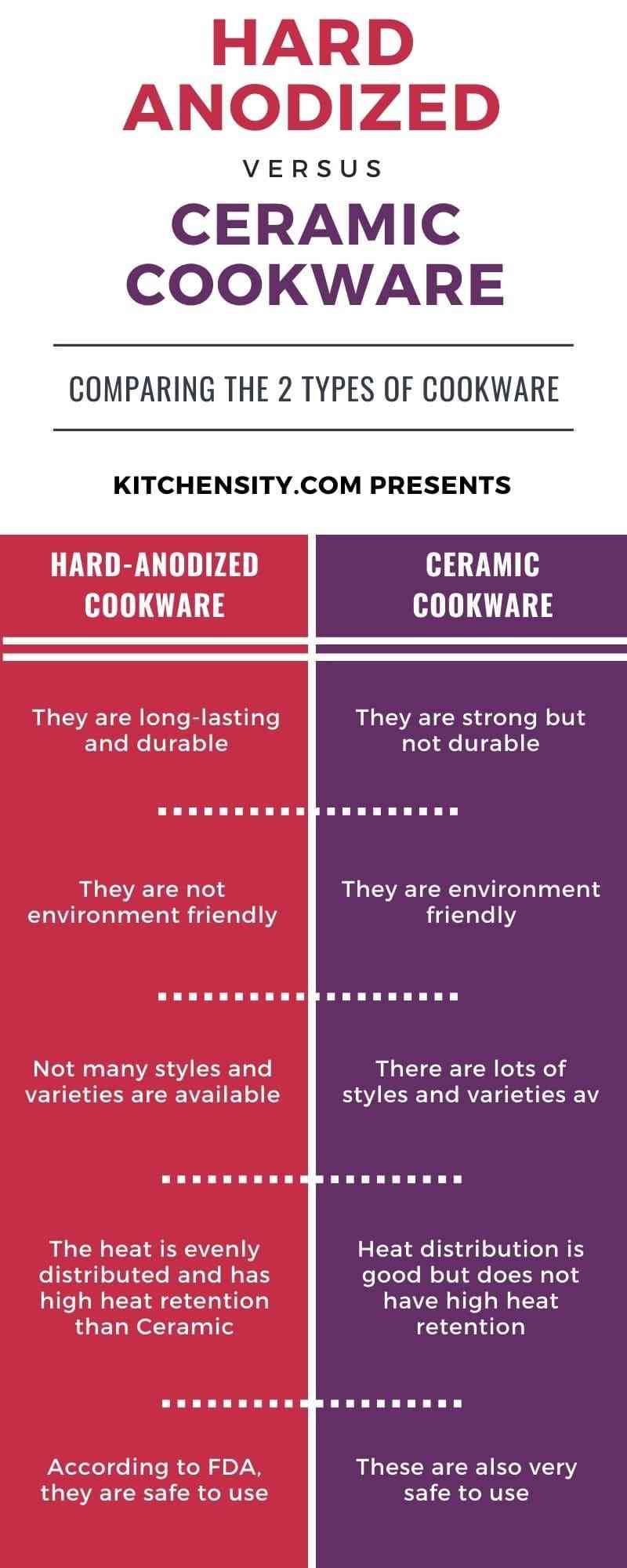
FAQ’s
-
What’s Better Hard Anodized Or Ceramic Cookware?
Both of them have equal pros and cons. It’s very difficult to say which one to choose. So, if you ask me then I would choose hard-anodized over ceramic because of its durability, scratch-resistant, and even heat distribution.
-
What’s The Difference Between Anodized And Ceramic Cookware?
In hard-anodization cookware, a layer of protection is coated over the aluminum to make it strong and non-reactive through the anodization method.
Ceramic cookware is made of metal pans where a coating of sand or silicone is used to make it smooth and glossy. They are made from naturally occurring materials. That’s why they are considered as environmentally friendly cookware. -
Is Hard Anodized Cookware Safe To Use?
Yes, they are safe to use as they are made by anodization method and you will not find any trace of harmful aluminum. According to the FDA, hard-anodized cookware is safe to operate compared to Teflon coated.
-
Should I Buy Ceramic Cookware?
Yes, you can buy ceramic cookware. It’s a personal opinion as both hard-anodized and ceramic have similar features except one or two.
-
Does Anodized Aluminum Wear Off?
No, anodized aluminum does not wear off. That’s why people prefer anodized over the traditional nonstick pan. You can check in detail here.
Katrina Smith is a seasoned expert with over 25 years of experience in all things related to cooking and the kitchen. As an avid cook and kitchen enthusiast, she is passionate about sharing her knowledge and expertise on cookware, kitchen appliances, kitchen tips, and kitchen staples.
Through her articles and reviews, Katrina aims to inspire and help others improve their cooking skills, experiment with different ingredients, and invest in quality cookware and appliances.

![How To Season And Clean Cast Iron Cookware? [4 Effective Ways] 4 How To Season And Clean Cast Iron Cookware](https://www.kitchensity.com/wp-content/uploads/2020/06/How-To-Season-And-Clean-Cast-Iron-Cookware.jpg)
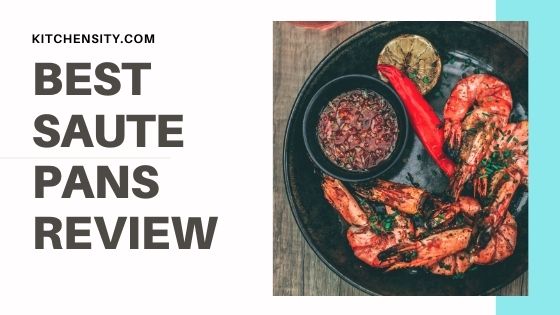
![Stainless Steel Vs Nonstick Vs Ceramic Cookware Set [An Ultimate Guide 2023] 6 Stainless Steel vs Nonstick vs Ceramic Cookware Set](https://www.kitchensity.com/wp-content/uploads/2019/09/Stainless-Steel-vs-Ceramic-vs-Nonstick-Cookware-Sets-e1621083482728.jpg)
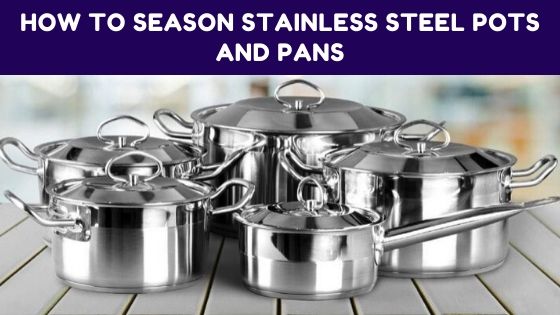
![What Pans Can You Use Cooking Spray On? [Ultimate Guide] 8 Types of pans with which cooking spray can be used](https://www.kitchensity.com/wp-content/uploads/2023/02/What-Pans-Can-You-Use-Cooking-Spray-On.jpg)
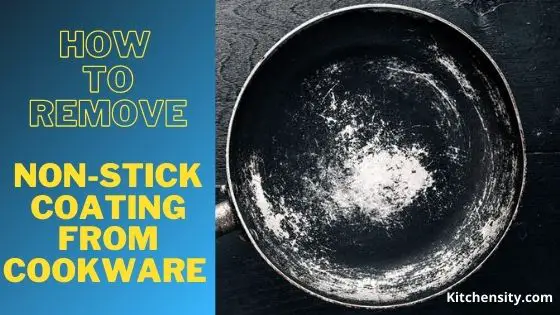
Thanks for the compliment!